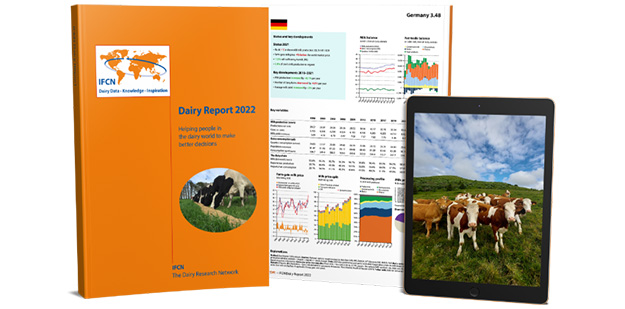This article is based on the IFCN Dairy Report 2022
IFCN is a global network for dairy economic research and consultancy. In 2022, researchers from over 100 countries and more than 140 agribusiness companies are members of the network. IFCN has created a better understanding of the dairy world for over 20 years.
IFCN Dairy Report has become a guideline publication for researchers and companies involved in the dairy chain, published annually since 2000. The analysis and the comprehensive data provide the background for strategic decisions and help people in the dairy world to make better decisions.

Key insights
With an increase of 2.9% compared to the previous year, milk production in 2021 remained at the level of recent years. However, a shift could be observed, i.e. typical net importing countries in particular contributed to the overall growth rather than the major milk exporters.
Demand for dairy products developed positively after many COVID-19-related restrictions were lifted worldwide. In addition, per capita demand continued to increase in South-East Asia and elsewhere.
World trade remained stable despite continued supply chain disruptions and exports increased again to satisfy the increasing demand.
Farm profitability was stable at the beginning of 2021, but later suffered from high input prices, which offset gains from the increase in milk prices. The world milk price increased by a remarkable 23.4% to 45 USD/100 kg milk (SCM) in 2021.
IFCN monitors global milk production on an annual and monthly basis including real-time estimates to provide one of the fastest market updates available, which is crucial to understand the milk price development. The Dairy Report comprises detailed information about key dairy indicators for 125 countries.
2021 production growth of 2.9%
World milk production growth did not increase in 2021 compared to 2020 and reached a total level of 959 mill t SCM (solid corrected milk, 4% fat and 3.3% protein). Especially in the typical export regions – New Zealand, European Union, as well as Argentina and Uruguay milk supply growth was subdued.
This is due in particular to difficult production conditions: New Zealand milk production declined stronger in the last quarter of 2021 than in the same period of the previous year (-3.9%) due to weather effects. The same could also be observed in the aforementioned South American countries. In Western Europe, dairy farm margins were under pressure as a result of high input costs, leading to a decline in production growth, while the situation in Eastern Europe was much better. This was also the case in the USA, where record high milk prices offset equally record high feed costs, improving farmers’ margins and boosting milk production. This means that net importing countries rather than traditional milk producers contributed to the overall growth of the sector in 2021. The high import prices for dairy products and their low availability have reinforced this effect.
Dairy demand keeps increasing in 2021
Following on from this, it became clear that growth in demand for dairy products (measured in milk equivalents) continues to take place in exactly these growth regions – especially in South and South-East Asia.
In 2021, the overall increase in demand was 3.2%, which corresponds to an increase of 1 percentage point compared to the previous year.
However, the COVID-19 pandemic brought changes to the consumption patterns. Some governments, as in the US, reacted with support programmes to keep production and consumption in check and thus contributing to a rising country demand. China, a good indicator of demand trends, also showed an 18% increase in imports in 2021 compared to 2020. Although it is unclear how much of this went into stocks, there continues to be an increase in per capita consumption. The picture for 2022 is looking a bit different, with a significant drop in imports – so it remains to be seen whether the large-scale national investment projects in a drive for more self-sufficiency will balance this out.
A decline of dairy demand on the other side could be observed in the EU and Latin America, where reduced availability of dairy products and higher prices led to lower demand.
Milk price development in 2021
The IFCN World Milk Price Indicator (Fig. 2), stood at an average level of 45 USD/100 kg milk (SCM) in 2021, 23.3 % higher than the previous year. This increase can be interpreted as a consequence of the higher feed price, the low raw milk production volumes with simultaneously stable milk demand and logistical problems.
Farm economics and the impact on price and production
At the beginning of 2021, farm profitability was stable. However, looking at the year as a whole, milk production costs globally increased by 10% on average, largely offsetting the increase in milk prices. 52% of farms were able to cover their full costs. Latin America, Asia and Oceania were the world regions with the best profitability. Western Europe improved slightly, albeit at a very low level. North America showed slightly lower profitability than in 2020, as the additional government support of the previous year was not continued. Less than half of the farms in the Middle East were profitable due to increased feed and transportation costs.
Looking ahead to 2022
The uncertainty and low growth rates of milk supply remain for the time being. In 2022, a continued decline in production growth was observed. A slight recovery at the global level is expected only at the end of 2022.
At the same time, the IFCN world milk price continued to rise, reaching a new record high of USD 63.0/100 kg SCM in April of 2022 – mainly due to tight global milk supply and firm demand growth. This situation reversed as inflationary pressures increased, leading to a slight decline in demand.
The wave of inflation is not only influencing consumer decision-making, but also causing farmers to cut back on investments. The rapid increase in prices of fertilisers, energy, wages, construction materials, etc. is putting pressure on the profit margins of dairy farms.
For the sector to recover, it will be important that farmers’ input costs no longer eat up the additional farm income from the still quite favorable milk prices.







